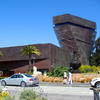More about Mother Earth
- All
- Info
- Shop

Contributor
Beginning in 1912 and continuing in 1922 and 1928, Chiura Obata (小圃 千浦) produced the painting Mother Earth as a way of prompting people to reconnect with the earth, in order to balance the energy of militaristic, speed-driven, consumer society.
In affinity with, and influencing, the introspective sensibilities of O'Keeffe, Miyazaki, and Ansel Adams, Obata urged us to "Get in closer contact with Mother Earth!" He appealed to everyone, "young or old, rich or poor, no matter what kind of occupation. Above the borderline of nationality everyone must feel a deep appreciation toward Mother Earth. The local soil, the local nature where we live."
Born Zoroku Sato to a family of samurai ancestry and an artist father, Obata was adopted by his older brother, Rokuichi, also an artist. The Meiji period in Japan lasted from 1868 to 1912, and one of its main ideas was kokutai, a unique term which "began with the unity of Shintō and Confucianism" and which eventually "became indistinguishable from" the ethic of "sensitivity toward nature, part of the special fūdo, or climate, of Japan, and inseparable from the indigenous beliefs of the traditional village community." In the final year of the Meiji period, when he began work on Mother Earth, Obata called the painting Night Fall on High Sierra, a reference to the mountains of California. He displayed an early version of the painting at the Miyagi Prefectural Library in April 1929, during an extended stay in Japan prompted by the passing of his father. Obata had been living in the United States, to which he had emigrated in 1903, but he remained actively engaged in the artistic and cultural currents in Japan, and it was important to him to show people back home his reflections on the landscape of California.
Writers and artists of the Meiji period worked to combine the indigenous practice of nihonga painting with the Western yōga mode, as painters of the two styles held each other in "mutual high regard." While yōga introduced the practice of three-dimensional vanishing points and unique colors, nihonga brought down unique line drawing techniques and materials, which Obata drew upon for his Mother Earth.
Sources
- Chiura Obat[a] Exhibition of Paintings. Mar. 6-26, 1928. San Francisco: East West Gallery of Fine Arts. de Young Museum Archive.
- First Annual Exhibition of Western Watercolor Painting. Dec. 5, 1932–Jan. 8, 1933. San Francisco: California Palace of the Legion of Honor. de Young Museum Archive.
- Irokawa, Daikichi. The Culture of the Meiji Period. Princeton: Princeton University Press, 1985.
- Obata, Chiura. "Art and Individuality." Lecture delivered at exhibition of Honor Students' Club, University of California, Berkeley, n.d.
- Szostak, John. Painting Circles: Tsuchida Bakusen and Nihonga Collectives in Early Twentieth Century Japan. Leiden: Brill, 2013.
- Wang, Shipu. Chiura Obata: An American Modern. Santa Barbara: UC Santa Barbara, 2018.












